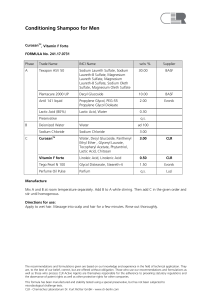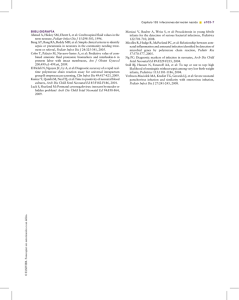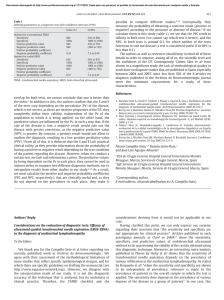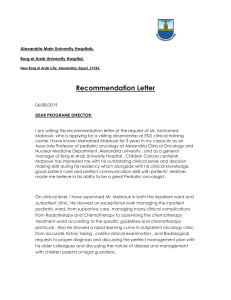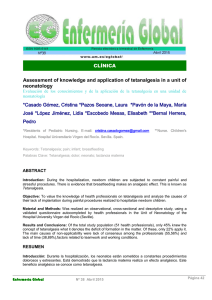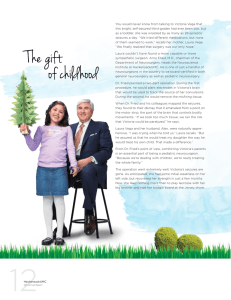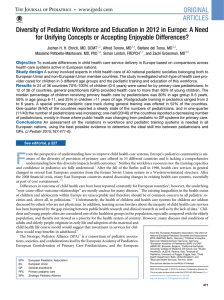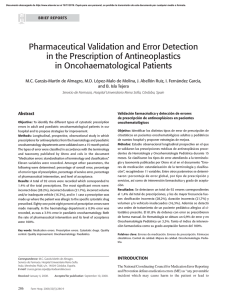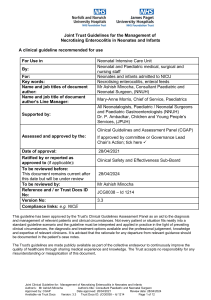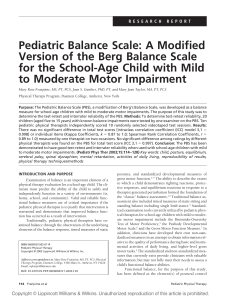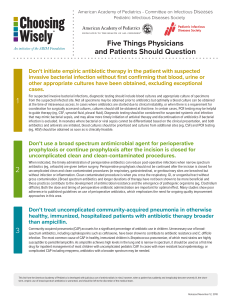Clinical trial and clinical pharmacology in neonates
Anuncio
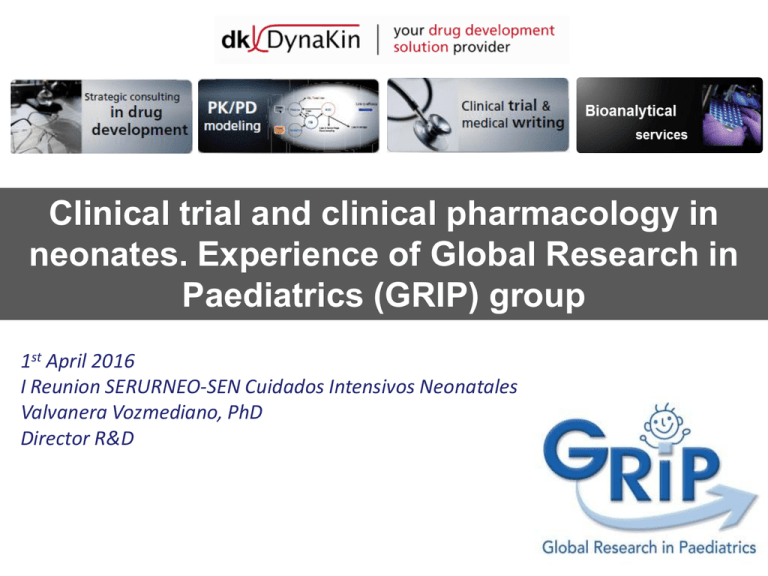
Clinical trial and clinical pharmacology in neonates. Experience of Global Research in Paediatrics (GRIP) group 1st April 2016 I Reunion SERURNEO-SEN Cuidados Intensivos Neonatales Valvanera Vozmediano, PhD Director R&D Some considerations to keep in mind Paediatric drug development is an “infant science” Regulatory policy must be balanced with science to successfully complete pediatric drug development studies New tools, as M&S tools, are needed to optimally design complex trials and test assumptions avoiding large clinical trials slide 2 © Dynakin SL. All rights reserved State of the Art clinical trials in paediatrics • • FDA of 189 products studies under paediatric exclusivity (1998-2012) 78 did not get the paediatric labelling, i.e. 42% FAILED [1] Main reasons for failure: dosing, differences in disease processes, trial design, placebo response. How can we improve the success rate of paediatric (or more specifically neonatal) trials? [1[ Wharton GT, Murphy MD, Avant D et al. Impact of Pediatric Exclusivity on Drug Labeling and Demonstrations of Efficacy. Pediatrics 2014: 134:e512–e518. slide 3 © Dynakin SL. All rights reserved Key considerations for neonatal CT Patients • Better identify similar populations (gestational age, confounding conditions) • Identify biomarkers to define subpopulations (diagnostic, prognostic biomarkers) • Effect of cofounding conditions and analyze the data base on subpopulations • Understanf the pathophysiology of unique conditions • Need to differenciate from the adult conditions Conditions • Diagnostic test with good sensitivity and specificity Drug • Differences in ADME processes and its implication of PK/PD studies • Formulations • Better definition of clinically relevant efficacy endpoints and the differences with the adult endpoints • Safety endpoints Endpoints • Innovative study designs: CT simulations, adaptive designs http://www.fda.gov/downloads/AdvisoryCommittees/CommitteesMeetingMaterials/PediatricAdvisoryCommittee/UCM342994.pdf slide 4 © Dynakin SL. All rights reserved What comes after the Dose given to a creature? effect ? Predicted and observed MPR% Dose Therapeutic Response 100 90 80 70 60 50 40 30 20 10 0 -10 0 10 20 30 40 50 60 70 80 90 100 110 120 130 Time (min) time – A lot can be learned or already known about how the drug passes through the body, the Pharmacokinetics – Pharmacokinetics (PK) and Pharmacodynamics (PD): The drug – organism interaction – Not much is usually known about the effect of the drug, Pharmacodynamics slide 5 © Dynakin SL. All rights reserved Differences between children and adults can be in PK (ADME) and/or PD • • • • • Absorption processes • Maturation of gastric properties (4-fold pH decrease from neonate to adult); efflux pumps; permeability (= Bioavailability) Distribution processes • Water/total volume ratios; Plasma protein binding; BBB more permeable in newborn Metabolism processes • Maturation of Hepatic and extra hepatic enzymes, flows Elimination processes • 10-fold increase in GFR from birth to adult; Active processes PharmacoDynamics • Changes in receptor expression; effect site access; pathway maturation Conclusion = Toxicity risks due to PK/PD! slide 6 © Dynakin SL. All rights reserved Including the influence of ontogeny in the PK processes Developmental changes which occur during growth and may influence the disposition of drugs in the body (Kearns et al., 2003). slide 7 © Dynakin SL. All rights reserved FDA assumptions-based framework Starting point to determine the pediatric studies (excluding oncology studies) necessary for labeling based on the ability to extrapolate efficacy from adult or other data slide 8 © Dynakin SL. All rights reserved Age range definitions Premature newborn < 37 weeks Full term newborn 37 weeks Term newborn infants (0 - 27 days) Infants and toddlers (2 to 23 months) Children (2 - 11 years) Adolescents (12 to 16-18 years*) *US 16 years/ EU 18 years slide 9 © Dynakin SL. All rights reserved Clinical trial design in the pediatric population: key factors Dose Selection Sampling scheme Number of children slide 10 © Dynakin SL. All rights reserved Strategies to optimize pediatric PK CT Optimal laboratory bioanalytical techniques 96 wells plate, SLE-LC-MS/MS, DBS, microdyalisis Optimal pharmacostatistical methodologies - Design improvement: less blood, less sampling, less children - Less ethical concerns: less blood, less sampling, less children - Better acceptance from the point of view of parents Mixed effect modeling strategies, MBDD When and how? … Case by case basis slide 11 © Dynakin SL. All rights reserved Application of different methods: Case by Case basis KNOWLEDGE UNCERTAINTIES/ASSUMPTIONS slide 12 © Dynakin SL. All rights reserved Quantitative extrapolation: What do we know? Developmental changes Clinical pharmacology of drug in adults: ADME PD Properties Safety and Tolerability Knowledge integrated into Predictive PK/PD Model Knowledge on the physiological systems involved slide 13 © Dynakin SL. All rights reserved Physicochemical characteristics + in vitro data slide 14 © Dynakin SL. All rights reserved 1st Step: development of a predictive model in pediatrics Incorporate into the model the ontogenic changes in PK and PD slide 15 © Dynakin SL. All rights reserved Prediction of elimination process CLs = CLH + CLR CLH_adult = 94 % 0.583 L/min CLH _ adult CLR_adult = 6 % 0.037 L/min QH fu CLint QH fu CLint 1.72 L/min Hayton 0.160 CLR _ neonate GFRneonate funeonate x CLR _ adult GFRadult fuadult CLint_ neonate GLW FCYP CLint_ adult 130/1800 = 0.072 20 % 0.22 L/min CLH _ neonate slide 16 funeonate 1 (1 fuadult ) Pneonate ) 1 Padult fuadult AGAadult=0.77g/L 0.160 Q fu CLint H QH fu CLint 0.887 edad 0.38 AGA( g / L) 0.890.38 edad 0.38 © Dynakin SL. All rights reserved 2nd step: dose selection in children using M&S techniques slide 17 © Dynakin SL. All rights reserved 3rd step is selection of samples to adequately describe the PK or PK/PD profile in each age subset Sampling times 3 4 6 8 10 12 24 100 300 500 0.8 0 Plasma Concentration(ng/mL) 0 0 5 10 15 20 25 30 TIME (hr) Sampling times 0.8 1 1.2 1.5 3 4 8 10 12 24 300 100 -2 -1 0 1 LOG TIME (hr) slide 18 6 500 0.5 0 Plasma Concentration(ng/mL) 0.25 © Dynakin SL. All rights reserved 2 3 Validation of predictive capacity of the model with few children for older ages 37 OBS., 7 CHILDREN (10 mg/day) Predictive check (VPC, PC-VPC, PPC) Concentration Simulate Calculateofthe 1000 mean profiles and the using confidence Monte Carlo interval techniques 95% at Superpose the observations within the simulation with theeach prediction time model Acceptance criteria 30% (normally 10%) Time slide 19 © Dynakin SL. All rights reserved Learn & Confirm: Adaptive designs LEARNING STAGE Maturation -based predictive PK/PD model for pediatrics (literature data) Interim analysis in a small group of patients CONFIRMING STAGE -Redesigning the study - Feeding the model - Stop recruitment slide 20 © Dynakin SL. All rights reserved Study design Innovative M&S tools • Strengths • • • • Challenges • • slide 21 Use limited PK data to optimize doses to be tested Better understanding of the mechanisms of disease to predict efficacy, safety and off-target effects More precise understanding of neonatal drug ADME/PD processes Need more basic science information for neonatal specific disease models Need more information on the ontogeny of enzyme systems to improve © Dynakin SL. All rights reserved Q&A Thank you for your attention!! vozmediano@dynakin.com slide 22 © Dynakin SL. All rights reserved
